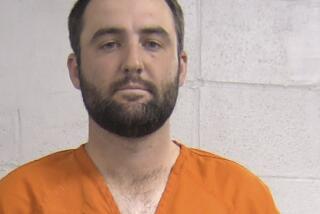Nobel Winner May Face Prison
- Share via
A 74-year-old Nobel laureate in physics may face prison time for slamming into a van at more than 100 mph last year, killing one passenger and injuring seven others just south of Santa Maria, Calif.
John Robert Schrieffer, a former professor at UC Santa Barbara who won the Nobel Prize in 1972 for a theory he helped formulate at the age of 26, was driving on a suspended Florida license at the time of the Sept. 24 collision, authorities said Wednesday. He had nine speeding tickets on his record.
At an emotional hearing this week in a Santa Maria courtroom, Schrieffer tearfully apologized to the crash victims, who are members of a Ridgecrest, Calif., family and their friends.
But Santa Barbara County Superior Court Judge James Herman was unmoved, sending Schrieffer to a state diagnostic facility where he is to be evaluated for a possible prison term.
On July 25, Schrieffer pleaded no contest to vehicular manslaughter, and probation officials recommended a sentence of eight months in Santa Barbara County Jail. But on Monday, Judge Herman, who took over the case after the plea was entered, said the scientist might “need a taste of state prison.” He delayed sentencing until Nov. 7.
Schrieffer was then taken to Wasco State Prison, where corrections experts are to examine him and recommend that the sentence be served either in prison or in county jail, a less restrictive setting.
Schrieffer is on leave without pay from Florida State University in Tallahassee, where he is chief scientist at the National High Magnetic Field Laboratory. He taught at UC Santa Barbara from 1982 to 1991 and directed the university’s Kavli Institute for Theoretical Physics for five years.
A San Diego attorney representing the plaintiffs in the wrongful-death lawsuit against Schrieffer called his scientific credentials irrelevant.
“From our standpoint, his pedigree doesn’t matter,” Stacy King said. “The only thing that matters is that he was driving recklessly.”
Schrieffer’s criminal defense attorney said his client was “extremely remorseful.”
“He’s not making any excuses,” said Roger Lytle of Santa Barbara. “He shouldn’t have been driving, and he’ll never drive again.”
Before the crash, Schrieffer had picked up a new Mercedes sports car in San Francisco and was heading down the coast to see friends in Santa Barbara. Meanwhile, the Ridgecrest group had hopped in the van and was making its way from a visit with friends in Guadalupe, Calif., to an outing at the Chumash Casino in Santa Ynez, northwest of Santa Barbara.
On U.S. Highway 101 near Orcutt, Schrieffer struck the van at 111 mph, according to the plaintiffs’ lawsuit.
Renato Catolos, a 57-year-old warehouse manager, died at the scene. Another passenger, 77-year-old Amparo Mangapit, died a month later. Though the victims’ attorneys contend that her death was caused by the crash, Schrieffer was charged only in the death of Catolos.
Another passenger was partially paralyzed and remains in a skilled-nursing facility with severe head injuries, said attorney King.
At the accident scene, Schrieffer initially denied any involvement, saying that a truck had tried to force him off the road, said Robert Mestman, the prosecutor in the case.
However, a witness contradicted his story and said fragments from the overturned van were embedded in Schrieffer’s car, Mestman said.
The 1972 Nobel Prize in physics was given to Schrieffer, John Bardeen and Leon Cooper for their work in explaining superconductivity -- the disappearance of electrical resistance in certain metals and ceramic materials under extremely cold temperatures. Their theory was developed in 1957, sparked in part by an insight into superconductivity that Schrieffer experienced on a New York subway.
The theory “enabled the development of huge amounts of technology,” said James Langer, a theoretical physicist at UC Santa Barbara who has known Schrieffer for nearly 50 years.
In addition, it has deepened scientific understanding of phenomena in fields such as astrophysics and brain research, said Langer, who also has directed the Kavli Institute for Theoretical Physics.
In reference to the fatal collision, Langer said: “This is a major tragedy.
“Something obviously has happened to Bob.”
More to Read
Sign up for Essential California
The most important California stories and recommendations in your inbox every morning.
You may occasionally receive promotional content from the Los Angeles Times.









